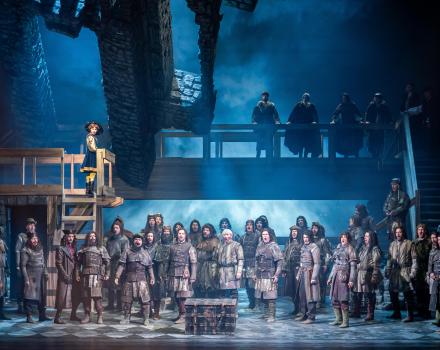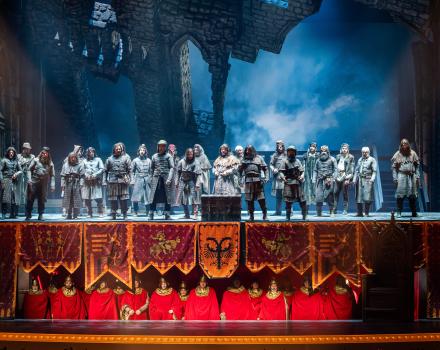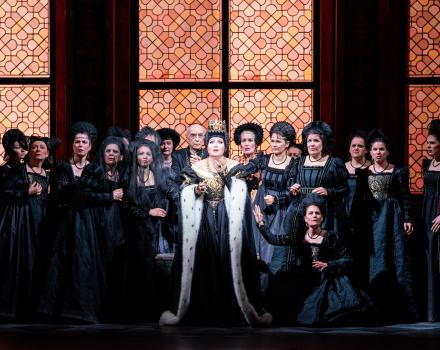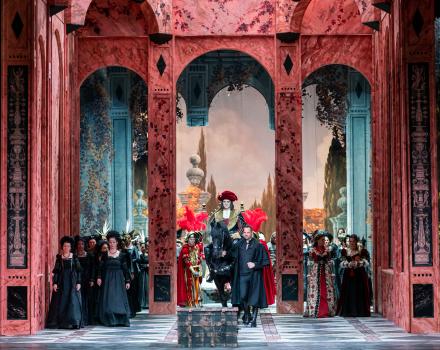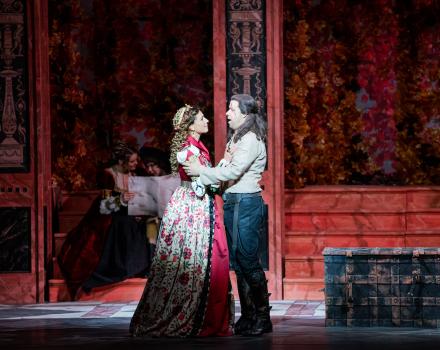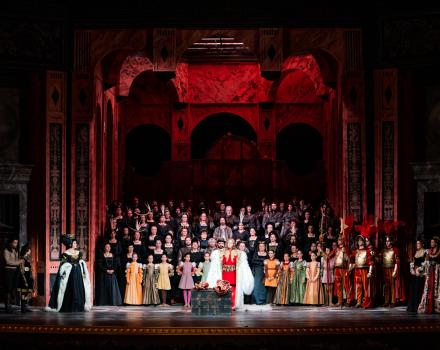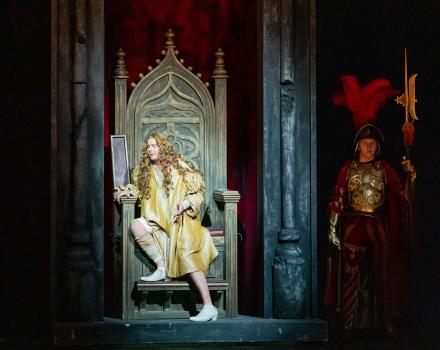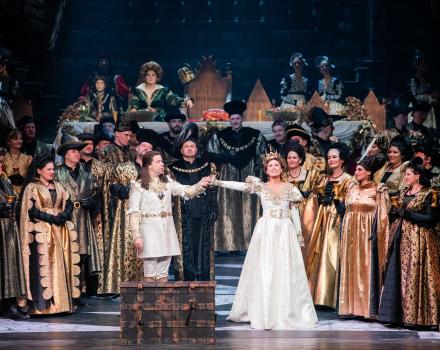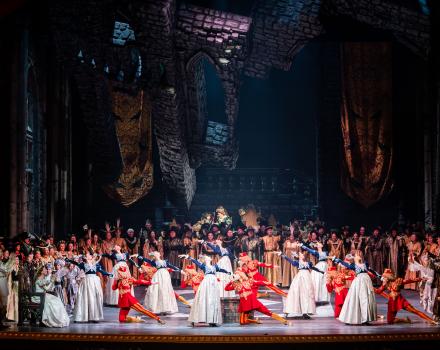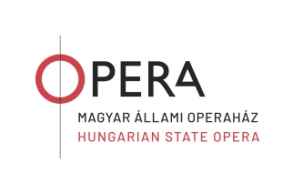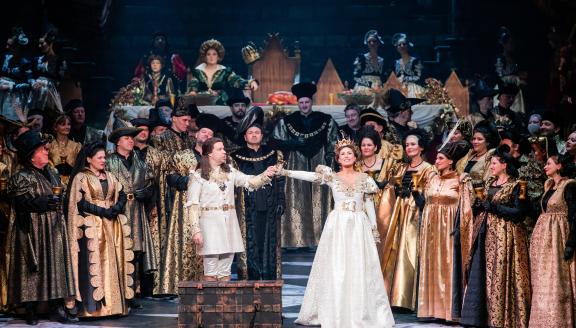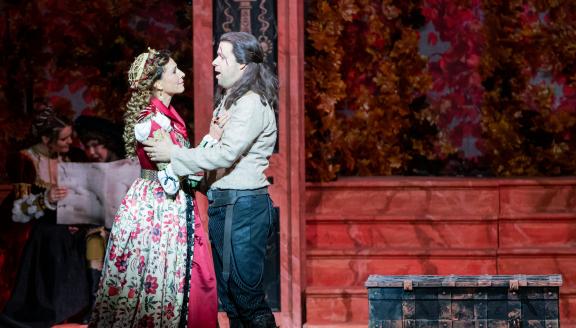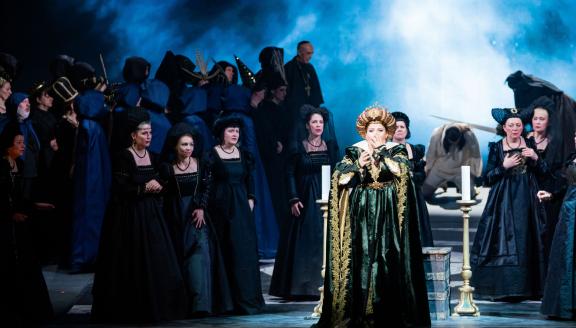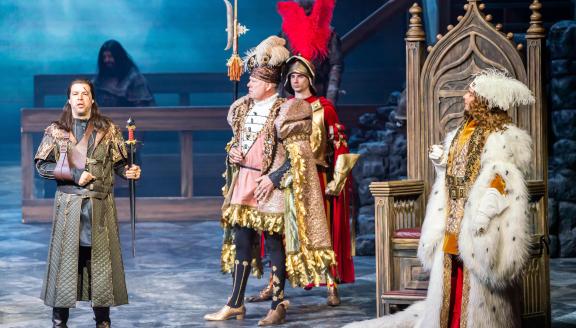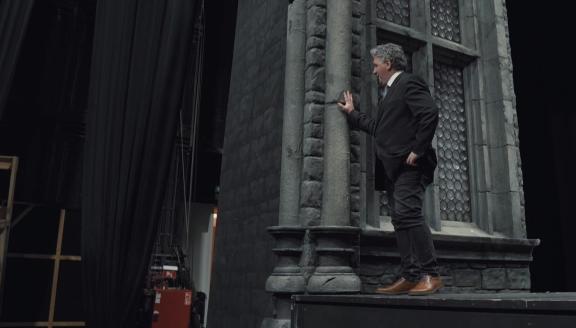
Hunyadi László is a historical grand opera from Hungary. The epic covers the life and death of the 15th-century soldier and politician, Hunyadi László, son of János Hunyadi who defended Hungary against the attacks of the Ottoman Turks. When the new weak King, László V, takes a shine to Mária, László's fiancée, the young man is arrested and his fate is sealed. The executioner’s axe falls - several times - on one of opera’s most grizzly finales.
Rivalling Bánk Bán as Ferenc Erkel’s most popular work, the success of Hunyadi László, which premiere in 1844, is undoubtedly linked to patriotic feeling at the time; nationalist crowds sang excerpts from the opera during the 1848 anti-Austrian revolution. Routed in conventional of grand historical opera, the music nonetheless has real individuality and Hungarian flavour, with orchestral rhythms remissent of Liszt’s Rhapsodies. This production was staged for the reopening of the magnificent opera house in Budapest in March 2022. Szilveszter Ókovács’s production comes complete with the original sumptuous costumes and authentic scenery, artfully combined with projections and the help of Hungarian State Opera’s brand new stage machinery.
Cast
King László V | Dániel Pataky |
|---|---|
Ulrik Cillei, the regent | András Palerdi |
Erzsébet Szilágyi | Klára Kolonits |
László Hunyadi | Szabolcs Brickner |
Mátyás Hunyadi | Melinda Heiter |
Miklós Gara | Gábor Bretz |
Mária Gara | Erika Miklósa |
Rozgonyi | Attila Erdős |
Dancers | Dancers of the Hungarian National Ballet Students of the Hungarian National Ballet Institute |
Orchestra | Hungarian State Opera Orchestra |
Chorus | Hungarian State Opera Chorus |
| ... | |
Music | Ferenc Erkel |
|---|---|
Text | Béni Egressy based on Lőrinc Tóth's drama |
Conductor | Balázs Kocsár |
Director | Szilveszter Ókovács |
Artistic consultant | András Almási-Tóth |
Sets and costumes | Krisztina Lisztopád |
Lighting | Tamás Pillinger |
Video design | Zsombor Czeglédi |
Stage managers | Resz Miklós |
Artistic assistant | Erika Tóth |
Assistant director | Mária Anna Kovács |
Choreographer | Tamás Solymosi |
Assistant choreographer | Marianna Venekei |
Chorus Master | Gábor Csiki |
Children Chorus Master | Nikolett Hajzer |
| ... | |
Videos
Story
Act I
The young soldier László Hunyadi, the eldest son of the dead hero János, is warned by his men that he is in moral danger from King László V but László humbly welcomes the latter. When foreign mercenaries are not allowed in the castle, Ulrik Cillei, a bitter enemy of the Hunyadis, uses this fact as a pretext to get permission to kill László. Hunyadi’s supporters are informed about his plan by Rozgonyi, whose role is not clear, and they kill the schemer. The startled King apparently forgives this deed.
Act II
Erzsébet Szilágyi, János’s widow, is worried for her son László after seeing a vision of him being handed to an executioner. The King makes a solemn promise to fully forgive them, and makes the two Hunyadi sons his honorary brothers. At the same time, he takes a liking to László’s fiancée, the beautiful Mária Gara, and the girl’s father, Miklós, instantly sees an ignoble opportunity.
Act III
Miklós Gara convinces the King, still passionate for Mária, to get rid of László Hunyadi. They arrest him at the engagement party of László and Mária, interrupting the celebration.
Act IV
Mária urges her imprisoned lover to escape but László trusts the King’s promise. Eventually, László is bound for the scaffold, and so Erzsébet Szilágyi has to watch as her nightmare comes true. The executioner strikes three times but the innocent youth still lives. Instead of showing mercy, Miklós Gara gives the order to strike him yet again, finally beheading Hunyadi.
Insights
Hunyadi László in context
Interview with conductor Balázs Kocsár
Not many operas had been written in Hungary before Ferenc Erkel’s time. Where could he turn for inspiration when composing for the stage?
Béla futása (Béla’s Flight), an opera by József Ruzitska, opened in Kolozsvár (today Cluj-Napoca) in 1822, exactly 200 years ago. Erkel visited the town, and it was a turning point for him when he saw the production and met the intellectual community there. Though German was his first language, Erkel was profoundly influenced by Hungarian culture. After leaving Kolozsvár he spent time in several towns before coming to Budapest. There he first worked as the choirmaster of the Várszínház (Castle Theatre) theatre, then he was invited to the newly founded Hungarian language theatre, Pesti Magyar Színház (Hungarian Theatre of Pest). He demonstrated professionalism beyond his years when, in his contract, he insisted on the right to decide who could sing, who could become members of the choir and the orchestra. He greatly improved the quality of music, and success came quickly. The goal was to become a real competitor to the German language theatre, Hungarian Theatre of Pest – and they did.
Erkel brought the popular pieces of his time to the stage, and audiences got familiar with the operas of Auber, Bellini, Cherubini, Donizetti and Rossini with Erkel as a conductor. He was greatly influenced by Italian bel canto with its melodic formation and the series of self-contained pieces (arias, duets etc.) with their distinctive structure. Besides bel canto, he was the most affected by French grand opéra, with its historical themes, monumental tableaus and dance scenes. Finally, his time in Kolozsvár, when he saw how Hungary became a part of the operatic scene, was also a formative experience for him and explains the ‘Hungarian elements’ – gypsy music, the verbunkos and palace dances – in his pieces.
Bátori Mária, an opera with almost exclusively bel canto characteristics, was a turning point in 1840, as this was when the state took over Hungarian Theatre of Pest – which was previously funded by the county – and it became a national theatre. Hunyadi László, however, transcended this opera. Erkel’s aim was to merge the musical styles he knew into one and create a Hungarian language opera, but he didn’t wish to innovate as such. His life’s work is absolutely unique. He stands alone among opera composers, having written all his operas about historical events of his homeland.
How can these types of opera you mentioned be interpreted with regard to the structure of Hunyadi László?
The plot of Hunyadi László is a historical theme that called for a grand opera in 3 acts. Interestingly, however, the lead character is not so much the titular character but Erzsébet Szilágyi, László and Mátyás Hunyadi’s mother. The reason for this lies in operatic conventions. A key characteristic of the lead character is that he/she sings the aria type aria di sortita, which follows this structural pattern: recitativo – cantabile – tempo di mezzo (middle part) – a fast cabaletta. Usually this is not at the beginning of the opera but is most often performed in the opening scene of the second act. Also, at the end of the opera there is either an aria of the lead character or a rondo-finale, where the lead character has a prominent role. In Hunyadi, this is all Erzsébet Szilágyi. Another key feature of the operas of the time is that the audience learns about the plot in the opening scene, mostly from the chorus, which transitions into an aria by a supporting character, which also explains the story. Originally, in this opera this was an aria by Mátyás. In their 1935 adaptation, Miklós Radnai, the director of the Opera, Kálmán Nádasdy, the director and Gusztáv Oláh, the set designer cut this aria from the opera.
Instead of their version, now Erkel’s original version is brought to the stage. What is your goal with reviving the original Hunyadi?
By reviving the traditional production from before the 1935 adaptation, we wish to show that Erkel’s original version, which was a huge success at the premiere, is, in the 21st century, still a living, powerful musical drama with real, flesh and blood characters.
What changes did Miklós Radnai and his colleagues introduce? What do you think about their adaptation – which is widely believed to be the original Hunyadi László?
It’s surprising for me that Radnai and the others did not believe in Erkel’s art. Verdi’s Nabucco and Wagner’s The Flying Dutchman were written in the same period, yet they haven’t lost their power, and while their style is rooted in bel canto, there is no need to modernise them. Radnai’s problem was that at the turn of the 19th and 20th centuries, Bánk bán and Hunyadi László were the only Hungarian operas. Another problem was to find a singer for Bánk’s tenor role, so a baritone version was written, the play was modernised, which was sort of absurd... Of course, creating new orchestrations and versions is quite common. In the case of baroque operas, every production is different. It is also exciting how you can reconstruct the original intent of the author, even when you use modern solutions or perhaps elements of jazz, like we do here at the Opera with Monteverdi’s Poppea and Purcell’s The Fairy Queen. But at the Opera, the audience is informed that this is an adaptation and there is no pretention that it is the original. Anyway, what we have come to know as Erkel’s Hunyadi and Bánk bán over the course of almost 80 years, are, while close to it, not the original versions.
In what ways is the version of Hunyadi László now presented to the audience original?
Parts that were left out have been brought back and regained their significance and place. Parts that were subsequently and unnecessarily overwritten were cut back. Interestingly, the most popular parts of Hunyadi, the Overture, László’s aria, the La Grange aria, the Palotás and Mária’s cabaletta were not part of the premiere on 27 January 1844, they were introduced later to the opera. Naturally, these parts will be included in the production. I believe that by reconstructing the original Hunyadi, we now have a more uniform and more colourful piece.
Gallery
